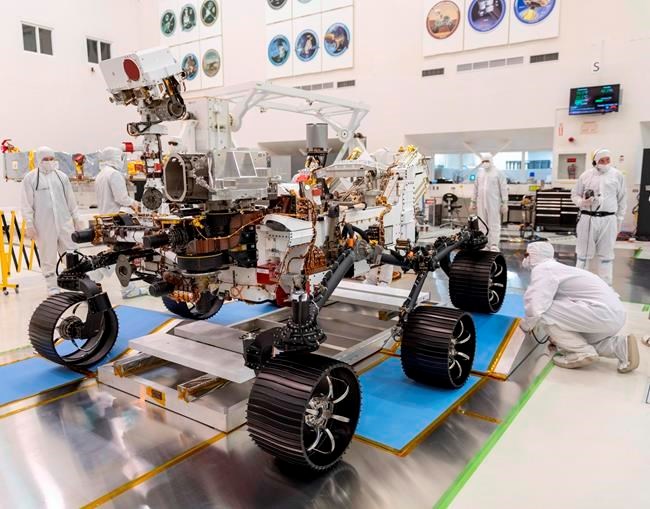EDMONTON — Chris Herd used to look into the sky when he was 13 and dream about holding a rock from Mars.
He may get his chance.
The University of Alberta planetary geologist is one of a select team of scientists working with NASA on a 10-year mission to Mars to bring back some of its rocks and to look for signs of life.
"It's amazing," said Herd.
"We're looking for those habitable environments that we can choose a sample from that will allow us to test that really big-picture question of whether life was ever there."
Herd, an expert in analyzing meteorites, is part of a team working on Perseverance, the latest Mars rover to be launched Thursday by NASA. Perseverance will land on the Jezero Crater, just north of the red planet's equator, drill into the surface and take between 20 and 35 core samples up to 10 centimetres long.
The rover will stash those samples on the surface. As early as 2026, another rover is to retrace Perseverance's steps and retrieve the samples for eventual return to Earth, perhaps by 2031.
"We're looking for environments recorded in the rocks there that could have been habitable — maybe organic matter from life," said Herd.
Mars is thought to have had water at some time in the distant past. About 3.5 billion years ago, something happened.
"The change on Mars was dramatic: from warmer weather with waters at the surface to drying out and rusting."
Jezero was chosen because it's thought to be an ancient lake bed. If there was life on Mars, lake sediments or a long-ago shoreline could be a good place to look for signs.
A route has been programmed into Perseverance. Herd's job, together with his colleagues, will be to monitor the rover and tell it when to sample.
Careful measurements of the immediate environment around the core are also to be taken.
Perseverance will be able to send much information back on its own. It has 23 cameras to record everything about the landscape and an on-board laser that can vaporize rocks and analyze their makeup.
Perseverance will be able to detect organic matter in the rocks and will carry ground-penetrating radar.
"There will be a lot of science to be done on the rover."
But proof of life will take an Earth-bound lab.
"The driver for the whole mission is looking for signs of ancient life," said Herd.
"That really does require samples to be brought back. If we're going to make that extraordinary claim, we need extraordinary evidence."
The mission could answer an old, old question dating back to the 19th century when astronomer Percival Lowell thought he spotted canals.
"Mars has flipped back and forth in our collective consciousness as to whether life is there. There was a whole time period where, if you asked the average person on the street if there were Martians, they'd probably say, 'Yeah.'"
Belief ebbed after fly-by missions showed a desolate planet. But further exploration found ice at the poles, raising the possibility of liquid water at least at some point in the planet's history.
"Now here we are, having followed the water," said Herd.
"We realize there were habitable environments in the past. It's pretty amazing to send a rover with the capability of taking samples ... to answer that question.
"It's really exciting."
This report by The Canadian Press was first published July 28, 2020
— Follow @row1960 on Twitter
Bob Weber, The Canadian Press




